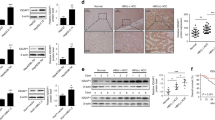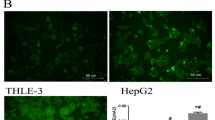Abstract
Elevated expression of CXCL9 has been shown to involve in the infiltration of inflammatory cells and liver damage after Hepatitis B virus (HBV) infection. However, whether and by what underlying mechanism does CXCL9 play a role in HBV infection associated hepatocellular carcinoma (HCC) invasion ability remain unclear. In this study, human HCC as well as adjacent noncancerous tissues, together with three kinds of liver cancer cell lines were investigated to clarify the possible involvement of CXCL9 in the regulation of HCC invasion and metastasis. Invasion ability of liver cancer cells were evaluated by transwell assays and it is enhanced after co-cultured with recombined human CXCL9 (rhCXCL9). As a trigger of Rac GTPase signaling after G protein-coupled receptors (GPCR) activated by CXCL9, Phosphatidylinositol-3, 4, 5-trisphosphate RAC Exchanger 2 (PREX2) mRNA expression of the liver cancer cell lines was elevated after co-cultured with rhCXCL9. Moreover, the mRNA level of PREX2 in HCC tissues was significantly higher than those in adjacent noncancerous tissues. Besides, the mRNA levels of PREX2 were positively correlated with the poor differentiation, portal vein invasion, metastasis and qualitative HbsAg results in 45 pairs of HCC specimens. Similarly, PREX2 mRNA was higher in three liver cancer cell lines when compared with the normal liver cell line whereas knocked down of PREX2 by small interference RNA (PREX2-siRNA) reduced the invasion ability of liver cancer cells in transwell assays. Overall, our results suggested CXCL9 was involved in the invasion ability of HCC possibly through up-regulation of its potential effector PREX2.





Similar content being viewed by others
References
Anson M, Crain-Denoyelle AM, Baud V, Chereau F, Gougelet A, Terris B, Yamagoe S, Colnot S, Viguier M, Perret C, Couty JP (2012) Oncogenic beta-catenin triggers an inflammatory response that determines the aggressiveness of hepatocellular carcinoma in mice. J Clin Invest 122:586–599
Barrio-Real L, Kazanietz MG (2012) Rho GEFs and cancer: linking gene expression and metastatic dissemination. Sci Signal 5:pe43
Ben-Neriah Y, Karin M (2011) Inflammation meets cancer, with NF-kappaB as the matchmaker. Nat Immunol 12:715–723
Berger MF, Hodis E, Heffernan TP, Deribe YL, Lawrence MS, Protopopov A, Ivanova E, Watson IR, Nickerson E, Ghosh P, Zhang H, Zeid R, Ren X, Cibulskis K, Sivachenko AY, Wagle N, Sucker A, Sougnez C, Onofrio R, Ambrogio L, Auclair D, Fennell T, Carter SL, Drier Y, Stojanov P, Singer MA, Voet D, Jing R, Saksena G, Barretina J, Ramos AH, Pugh TJ, Stransky N, Parkin M, Winckler W, Mahan S, Ardlie K, Baldwin J, Wargo J, Schadendorf D, Meyerson M, Gabriel SB, Golub TR, Wagner SN, Lander ES, Getz G, Chin L, Garraway LA (2012) Melanoma genome sequencing reveals frequent PREX2 mutations. Nature 485:502–506
Chen X, Pan M, Han L, Lu H, Hao X, Dong Q (2013) miR-338-3p suppresses neuroblastoma proliferation, invasion and migration through targeting PREX2a. FEBS Lett 587:3729–3737
Cui X, Liu Y, Wan C, Lu C, Cai J, He S, Ni T, Zhu J, Wei L, Zhang Y, Qian H (2014) Decreased expression of SERPINB1 correlates with tumor invasion and poor prognosis in hepatocellular carcinoma. J Mol Histol 45:59–68
de Martel C, Ferlay J, Franceschi S, Vignat J, Bray F, Forman D, Plummer M (2012) Global burden of cancers attributable to infections in 2008: a review and synthetic analysis. Lancet Oncol 13:607–615
Donald S, Hill K, Lecureuil C, Barnouin R, Krugmann S, John Coadwell W, Andrews SR, Walker SA, Hawkins PT, Stephens LR, Welch HC (2004) P-Rex2, a new guanine-nucleotide exchange factor for Rac. FEBS Lett 572:172–176
El-Serag HB, Rudolph KL (2007) Hepatocellular carcinoma: epidemiology and molecular carcinogenesis. Gastroenterology 132:2557–2576
Fernandez-Zapico ME, Gonzalez-Paz NC, Weiss E, Savoy DN, Molina JR, Fonseca R, Smyrk TC, Chari ST, Urrutia R, Billadeau DD (2005) Ectopic expression of VAV1 reveals an unexpected role in pancreatic cancer tumorigenesis. Cancer Cell 7:39–49
Franceschi S, Montella M, Polesel J, La Vecchia C, Crispo A, Dal Maso L, Casarin P, Izzo F, Tommasi LG, Chemin I, Trepo C, Crovatto M, Talamini R (2006) Hepatitis viruses, alcohol, and tobacco in the etiology of hepatocellular carcinoma in Italy. Cancer Epidemiol Biomarkers Prev 15:683–689
Ganem D, Prince AM (2004) Hepatitis B virus infection–natural history and clinical consequences. N Engl J Med 350:1118–1129
Gilmore TD (2003) The Re1/NF-kappa B/I kappa B signal transduction pathway and cancer. Cancer Treat Res 115:241–265
Hernandez L, Hsu SC, Davidson B, Birrer MJ, Kohn EC, Annunziata CM (2010) Activation of NF-kappaB signaling by inhibitor of NF-kappaB kinase beta increases aggressiveness of ovarian cancer. Cancer Res 70:4005–4014
Li J, Lau G, Chen L, Yuan YF, Huang J, Luk JM, Xie D, Guan XY (2012) Interleukin 23 promotes hepatocellular carcinoma metastasis via NF-kappa B induced matrix metalloproteinase 9 expression. PLoS One 7:e46264
Lindsay CR, Lawn S, Campbell AD, Faller WJ, Rambow F, Mort RL, Timpson P, Li A, Cammareri P, Ridgway RA, Morton JP, Doyle B, Hegarty S, Rafferty M, Murphy IG, McDermott EW, Sheahan K, Pedone K, Finn AJ, Groben PA, Thomas NE, Hao H, Carson C, Norman JC, Machesky LM, Gallagher WM, Jackson IJ, Van Kempen L, Beermann F, Der C, Larue L, Welch HC, Ozanne BW, Sansom OJ (2011) P-Rex1 is required for efficient melanoblast migration and melanoma metastasis. Nat Commun 2:555
Liu Z, Wu X, Zhang F, Han L, Bao G, He X, Xu Z (2013) AhR expression is increased in hepatocellular carcinoma. J Mol Histol 44:455–461
Mantovani A (2009) Cancer: inflaming metastasis. Nature 457:36–37
Mantovani A, Allavena P, Sica A, Balkwill F (2008) Cancer-related inflammation. Nature 454:436–444
Muller A, Homey B, Soto H, Ge N, Catron D, Buchanan ME, McClanahan T, Murphy E, Yuan W, Wagner SN, Barrera JL, Mohar A, Verastegui E, Zlotnik A (2001) Involvement of chemokine receptors in breast cancer metastasis. Nature 410:50–56
Murakami T, Kawada K, Iwamoto M, Akagami M, Hida K, Nakanishi Y, Kanda K, Kawada M, Seno H, Taketo MM, Sakai Y (2013) The role of CXCR3 and CXCR4 in colorectal cancer metastasis. Int J Cancer 132:276–287
Obermajer N, Doljak B, Kos J (2009) Cytokeratin 8 ectoplasmic domain binds urokinase-type plasminogen activator to breast tumor cells and modulates their adhesion, growth and invasiveness. Mol Cancer 8:88
Ott JJ, Stevens GA, Groeger J, Wiersma ST (2012) Global epidemiology of hepatitis B virus infection: new estimates of age-specific HBsAg seroprevalence and endemicity. Vaccine 30:2212–2219
Rosenfeldt H, Vazquez-Prado J, Gutkind JS (2004) P-REX2, a novel PI-3-kinase sensitive Rac exchange factor. FEBS Lett 572:167–171
Sun J, Liu W, Adams TS, Li X, Turner AR, Chang B, Kim JW, Zheng SL, Isaacs WB, Xu J (2007) DNA copy number alterations in prostate cancers: a combined analysis of published CGH studies. Prostate 67:692–700
Thelen M (2001) Dancing to the tune of chemokines. Nat Immunol 2:129–134
Thompson BD, Jin Y, Wu KH, Colvin RA, Luster AD, Birnbaumer L, Wu MX (2007) Inhibition of G alpha i2 activation by G alpha i3 in CXCR3-mediated signaling. J Biol Chem 282:9547–9555
Wu YY, Chen L, Wang GL, Zhang YX, Zhou JM, He S, Qin J, Zhu YY (2013) Inhibition of hepatocellular carcinoma growth and angiogenesis by dual silencing of NET-1 and VEGF. J Mol Histol 44:433–445
Xia LM, Huang WJ, Wu JG, Yang YB, Zhang Q, Zhou ZZ, Zhu HF, Lei P, Shen GX, Tian DA (2009) HBx protein induces expression of MIG and increases migration of leukocytes through activation of NF-kappaB. Virology 385:335–342
Yang L, Huang J, Ren X, Gorska AE, Chytil A, Aakre M, Carbone DP, Matrisian LM, Richmond A, Lin PC, Moses HL (2008) Abrogation of TGF beta signaling in mammary carcinomas recruits Gr-1+CD11b+myeloid cells that promote metastasis. Cancer Cell 13:23–35
Zhou Y, Wang S, Ma JW, Lei Z, Zhu HF, Lei P, Yang ZS, Zhang B, Yao XX, Shi C, Sun LF, Wu XW, Ning Q, Shen GX, Huang B (2010) Hepatitis B virus protein X-induced expression of the CXC chemokine IP-10 is mediated through activation of NF-kappaB and increases migration of leukocytes. J Biol Chem 285:12159–12168
Zlotnik A, Yoshie O (2000) Chemokines: a new classification system and their role in immunity. Immunity 12:121–127
Acknowledgments
This work was supported by research grants from the National Natural Science Foundation of China (Nos. 81270507; 81100264; 81100498).
Conflict of interest
All the authors declare no conflict of interest.
Author information
Authors and Affiliations
Corresponding author
Additional information
Xiaoqin Lan and Fang Xiao have contributed equally to this work.
Rights and permissions
About this article
Cite this article
Lan, X., Xiao, F., Ding, Q. et al. The effect of CXCL9 on the invasion ability of hepatocellular carcinoma through up-regulation of PREX2. J Mol Hist 45, 689–696 (2014). https://doi.org/10.1007/s10735-014-9593-0
Received:
Accepted:
Published:
Issue Date:
DOI: https://doi.org/10.1007/s10735-014-9593-0




